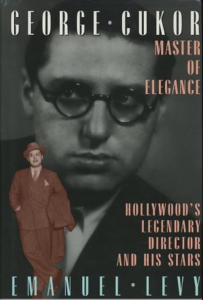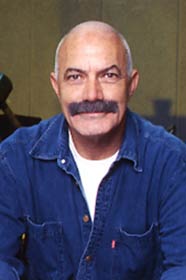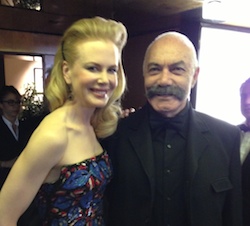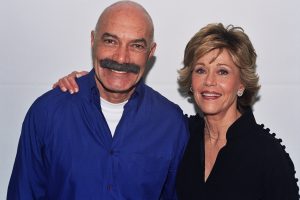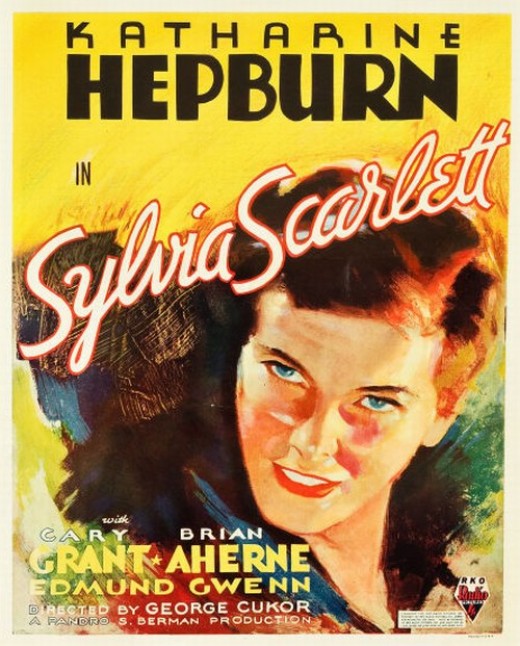
Cukor was intrigued by the book, which was the story of petty crooks on the run that give up crime to become vagabond actors.
With three strong characters–Henry Scarlett (Edmund Gwenn), a hard-luck embezzler forced to flee France; his daughter Sylvia (Hepburn), disguised as a boy to help him; and Jimmy Monkley (Cary Grant), a raffish Cockney who joins them–Cukor was convnced that he had the making of a fresh, offbeat film.
Playing Sylvia-Sylvetser was a most suitable part for Katharine Hepburn’s boyish quality, one that Cukor immediately detected. Always risk-taking, Hepburn relished playing a young chap, to whom both men and women feel attracted.
When a handsme rural artist, Michael Fane (Brian Aherne), is attracted to her, he says, “There’s something very queer going on here,” using the term queer decades before it became acceptabe. The word queer did not have the same meaning–and gay connotation–that it would acquire in later decades.
Things get further comlicated when, later on, a maid finds Sylvia attractive and kisses her.
Originally, the story started aboard the ship–when Hepburn is already disguised as a boy. The prologue was tacked on as a sympathy device–poor girl, her mother died, what else could she do, but….
The ending was also weak and contrived; its sole purpose was to get Hepburn away from Grant and back to the artist.
Worse yet, the subplot of Lili Levitsky (Natasha Paley), as Aherne’s older girlfriend who almost drowns. Her existence had little to do with the rest of the film, and Paley’s awkward Russian accent made it worse.
In its day, the film’s sexual ambiguities and gender misunderstandings were considered to be too daring, especially after the enforcement of the Production Code in 1934.
Regrettably, audiences in the Depression era didn’t see the humor in the film’s cross-dressing, and the pathos in a tale of mistaken identities, assumed by individuals for their survival.
Initially, producer Pandro Berman wanted to cast Errol Flynn, then a dashing Australian with limited Hollywood experience, as the rural artist. However, after meeting Flynn for only five minutes, Cukor dismissed him as “unqualified” (partly due to Flynn’s arrogance) and the subtle role was assigned to a more sensitive actor like Brian Aherne.
At the special request of his old friend, actress Elsa Maxwell, Natasha Paley, a bona fide Russian princess, was cast as Aherne’s love interest, even though her English was bad. It’s a favor that Cukor later regretted.
But the most significant piece of casting was Cary Grant, featured here in a pivotal role that would change the course of his career. Under contract at Paramount, Grant was typed as a conventional leading man and cast in relatively unimportant parts; he was second banana to the studio’s main star, Gary Cooper.
The women in Grant’s 1930s films (Mae West, Joan Bennett) would get top billing and he was often listed third or fourth in those films. It was not until Cukor directed him in “Sylvia Scarlet,” his first important role, that Grant’s batural flair for comedy truly emerged.
Grant, who had been a circus stilt-walker in his childhood and acrobat in his boyhood, was familiar with his character’s raffish personality. As a Cockney trickster, Grant stole the picture and went on to a triumphant career as a romantic wise-guy.
In the future, Cukor would remind Grant that he got his breakthrough in his movie, and would cast him in two of his better pictures, Holiday in 1938 and The Philadelphia Story in 1940
Cukor persuaded Brit John Collier to come to Hollywood and write the screenplay; the final script is credited to Collier, Gladys Unger and Mortimer Affner.
In the end, the movie told a curious story, burdened by a jumbled plot and labored, incoherent dialogue. s a result, Cukor’s treatment of the material was also inconsistent, in part whimsical, in part allegorical.
The final film is sharply uneven, though some scenes are really good. Hepburn was lovelier and more compelling in the first part, which is both strange and funny. As the awkward heroine, the mode in which she handles her body, the way she runs, and her haircut were all appropriately boyish. (The actress’ chiseled face easily lent itself to such treatment). The actress’s painful vulnerability and romantic-sexual longings were as apparent in this film as they were in Cukor’s 1933 movie, Little Women. But Cukor later acknowledged that Hepburn was too affected in the second half, possibly a result of the incoherent script.
The opening scene, after Sylvia’s mother has died and she cuts off her hair in order to sell it–was put in later in order to provide a more “plausible” reasoning.
Cukor went on the limb with “Sylvia Scarlett,” and got clobbered for it by some critics, but he refused to indulge in self-pity. Always the pragmatic, it was just one feature that followed a string of successes, including Little Women and David Copperfield, and one that would be followed by some of his best picture, the 1937 Camille, featuring Garbo in her best dramatic performance.
Still, the failure “Sylvia Scarlet” made him more cautious. “It slowed me up,” he later told interviewer Gavin Lambert, “I wasn’t going to be so goddamned daring after that.”
Made on a budget of $641,000, the film earned less than half a million dollars at the box-office, and RKO declared a financial loss, though not a major one.
A commercial flop, “Sylvia Scarlett” disappeared from the market for some decades, but then it began to acquire an underground reputation to the point of becoming a minor cult film. From the 1960s on, the picture never stopped playing at art theaters in the big cities, film museums, and festival retrospectives of Cukor, Grant, and Hepburn.
Cukor often joked that it took “a mere 35 years” for the movie to come into its own. And he continued to have affection for the picture, which allowed both Grant and Hepburn to be freer in their cnduct, engaging in antics that would be missing from their future work,
Nothing would delight Cukor more than the comment of future critics that Sylvia Scarlett was well ahead of its times.
Credits
Released: January 3, 1936
Running time: 94 minutes
Produced by Pandro S. Berman
Directed by George Cukor
Screenplay: Gladys Unger, John Collier, and Mortimer Affner, based on the novel by Compton Mackenzie
Camera: Joseph August
Art Director: Roy Webb
Editor: Jane Loring
Costumes: Muriel King (for Hepburn) and Bernard Newman for Paley
Music: P.J. Faulkner
Cast
Sylvia Scarlett (Katharine Hepburn)
Jimmy Monkley (Cary Grant)
Michael Fane (Brian Aherne)
Henry Scarlett (Edmund Gwenn)
Lily (Natalie Paley)
Maudie Tilt (Dennie Moore)
Drunk (Lennox Pawle)
